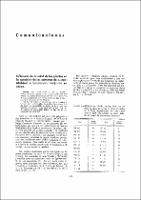Influencia de la edad de las plantas en la aparición de los síntomas de susceptibilidad a Ceratocystis fimbriata en cacao
Abstract
The sudden death of "Mal de Machete" disease of cacao, caused by the fungus Ceratocystis fimbriata, has caused serious losses of trees and of production in cacao populations with Criollo genes, as this variety is the most susceptible to the diseases. Tree by tree records of several experiments in cacao at La Lola farm and Turrialba, Costa Rica, have shown that the maximum susceptibility to deaths by the disease was between the seventh to the ninth year of age. The lack of response of susceptibility before this age and its consequence are discussed
Keywords
Theobroma cacao||Theobroma cacao||Theobroma cacao||Theobroma cacao, Plántula||seedlings||plântula||plantule, Ceratocystis fimbriata||Ceratocystis fimbriata||Ceratocystis fimbriata||Ceratocystis fimbriata, Resistencia a la enfermedad||disease resistance||resistência aos agentes patogénicos||résistance aux maladies, Enfermedad fungosa||fungal diseases||doença fúngica||maladie fongique, Cultivo||cultivation||prática cultural||pratique culturale,
Delegation
Sede Central
Publisher
Instituto Interamericano de Cooperación para la Agricultura (IICA)
Is part of
Turrialba Vol. 23, no. 2
Status
openAccess
URI (Permanet link to cite or share this item)
https://repositorio.catie.ac.cr/handle/11554/13005Collections
- Turrialba [2324]


